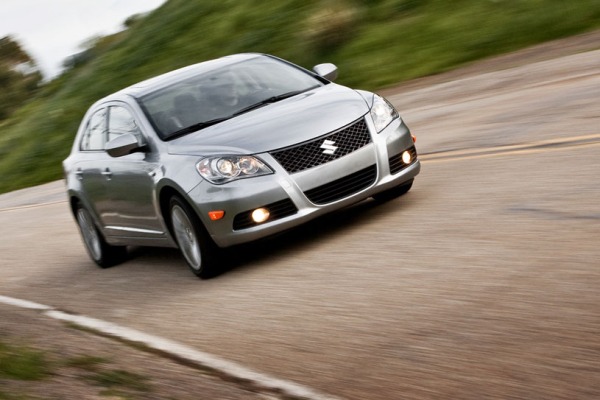
The Suzuki Kizashi used to be the kind of car that, if someone who cared about sound bought it, they'd drive straight to a car audio shop to rip out the anemic stock system and replace it with aftermarket audio gear. But our long-term 2010 Suzuki Kazashi GTS comes standard with a 425-watt Rockford Fosgate sound system, complete with an 8-inch subwoofer.
And while some branded premium systems in cars in this segment can cost quite a bit more given that they're often bundled with other features in an option package, the Kizashi's Rockford system -- like the car itself -- offers great value. And very good, if not great, sound.
The Setup
The Kizashi's system consists of 10 speakers powered by a 425 watts pumped out to eight channels. The speakers include a 6-inch midbass and 1-inch tweeter in each front door, a 2-inch midrange in the center of the dash, a two-way coaxial speaker in each rear door with another 6-inch mid and 1-inch tweet and an 8-inch dual-voice-coil subwoofer in the rear deck. The front-door midbass drivers and rear-door coaxials get 50 watts each, the front tweeters and center channel get 25 watts and the sub gets 150 watts.
The Sound
As with each and every system I evaluate, the Kizashi's got the full treatment: Playing music tracks I've listened to in hundreds of cars to test for clarity/lack of distortion, tonal balance, timbre, tonal accuracy, soundstaging, imaging and dynamics, and then spinning several non-musical test tracks to further gauge soundstaging and imaging and also judge linearity and absence of noise. For more detail on the testing process and tracks used, check out the Edmunds.com article Sound Advice.
It's a good thing that automakers have gotten hip to the kind of palpable impact that a subwoofer can add to a system, as more OEM systems now have a dedicated sub. But all too often it adds boom as opposed to making a system more musical. Of course, there are tone controls to dial the bass down or up depending on your musical tastes. But I test car sound systems with all audio controls set at the center detent, and usualy when a premium system in an economy car like the Kizashi has a subwoofer, the overall sound tends to be too bass-heavy. (I've also noticed the same thing with Rockford systems in Mitsubishi vehicles.)
With most of my test tracks, low- and mid-bass dominated the overall sound of the Kizashi's system, muddying tonal balance, timbre and tonal accuracy. On tracks that I use to test for low-bass extension, like Joan Armatrading's "In Your Eyes" and Outkast's "Ain't No Thang," output from the sub was satisfyingly deep and solid, but also slightly distorted, while tracks with strong midbass energy, like Red House Painters' "Cabezon" and Luka Bloom's "Cold Comfort" were marred by overbearing bass. Still, I'd rather have too much bass than not enough, and a twist or two of the bass control toned down the Kizashi's sub so that it was more to my taste and it wasn't overpowering the rest of the frequency spectrum.
The system also had a bit of high-end harshness, particularly with acoustic guitars and cymbals, although nothing too annoying. And it was relatively smooth throughout the midrange and upper-treble frequency range and exhibited good dynamics. But where it really excelled was in producing a soundstage that was immensely wide and way deep and creating a thoroughly accurate imaging. The stage easily extended beyond the width of the vehicle and images within it were spatially separated and largely located exactly where they were supposed to be.
One test track I use, Bluesiana Triangle's "Shoo Fly Don't Bother Me," is an extended jazz jam with a very spacious mix and features a flute solo that floats above the center of the dash with the best systems. In the Kizashi, the flute imaged dead-center, while the song's multiple layers of percussion were perfectly spaced and placed around it, giving the soundstage a three-dimensional quality. These sonic perceptions were verified by the non-musical staging and imaging tests. In one, spoken voices are mixed so that they are left, center and right in the stage; in another, seven drumbeats march across the dash at precise intervals. They did this almost perfectly on both tracks. With the linearity test, a measure of how well the system's sound holds together at low and mid volume, the Kizashi rated poor and fair, respectively. And it passed the absence of noise test, which most systems usually do.
The Sources
Our 2010 Kizashi GTS comes with an AM/FM/CD player and USB/iPod integration (but no aux-in jack) as well as Bluetooth audio. While the Kizashi doesn't have the best iPod integration out there, it's also not the worst. Getting through the menus takes a bit too much button-pushing to settle on the selection you want. It also doesn't include such iPod categories as audiobooks and podcasts, although that's not unusual. One of the system's biggest disadvantages is the cheesy LED display, which can't always display all of a track's metadata and washes out in bright sunlight.
What We Say
The Kizashi has inspired something of a love fest on this blog. Post after post praises the compact sedan's performance, styling, comfort, interior space and attention to detail. It's also has standard tech features like pushbutton start and Bluetooth hands-free that are uncommon in a car costing less than $24,000. While the stock Rockford Fosgate audio system isn't perfect, it's perfectly fine for most ears and is a bargain considering it comes standard with such a budget-priced car. And you'd have to be a fool or a hardcore audiophile to want to rip it out and start from scratch.
The Scores
Sound: B-
Source Selection: A-
iPod Integration: B
Cost: A+